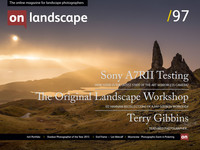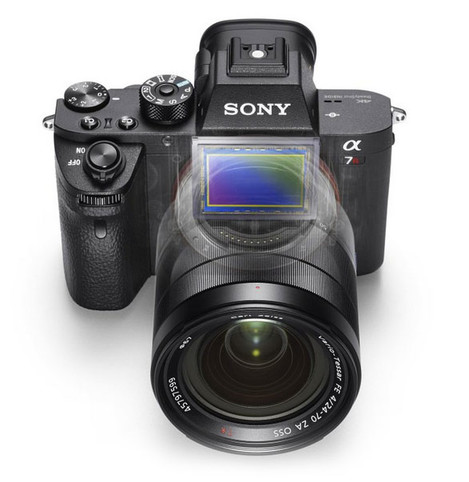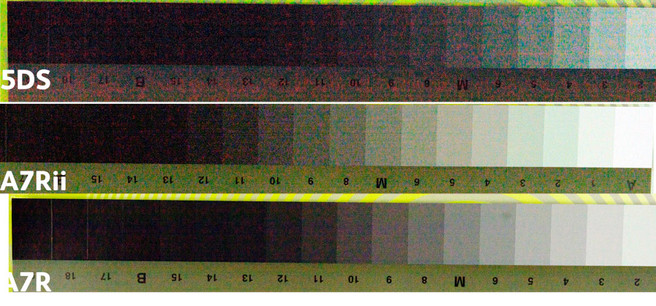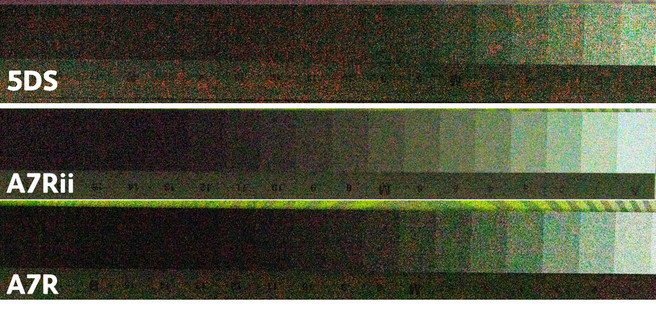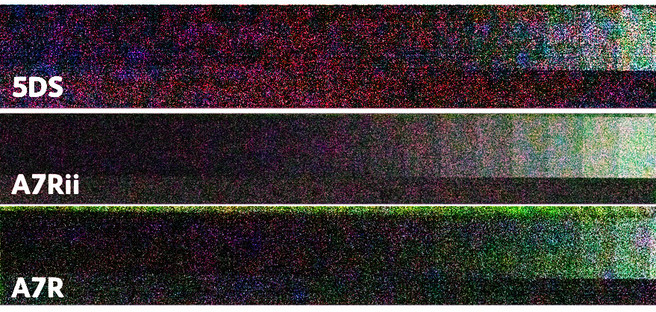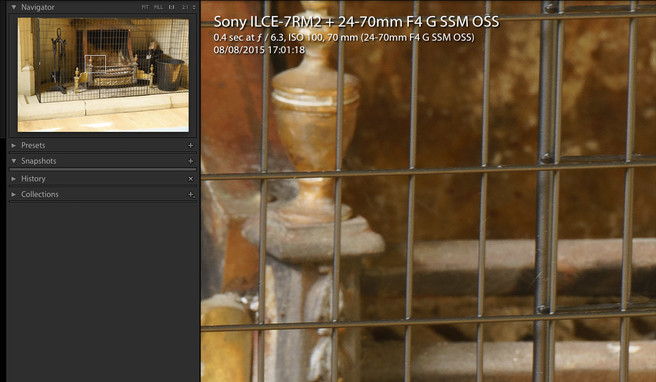Final Conclusions

Tim Parkin
Amateur Photographer who plays with big cameras and film when in between digital photographs.
Well this has been a bit longer than usual for our reviews as we think this is one of those “5D mark II/D800” points in time when cameras have achieved new levels of ability. The Canon 5DSr and the Sony A7Rii offer the highest resolution and some of the highest sensitivity at high resolution available and it would be remiss not to compare and contrast them.
In case you missed our first 3 articles we've published on the Canon 5DSr and Sony A7Rii, here's a recap:
- Sony A7Rii compared with Sony A7R & Canon 5DSr
- Sony A7Rii - more comparison and discussion
- Testing the Canon 5DS(r)
Before we get there though I want to thank Hire a Camera, Canon and Park Cameras for their help in supplying equipment to us. We borrowed a D810 and a couple of Sigma lenses from Hire a Camera, a 5DSr and a 5Ds and a bunch of lenses from Canon and had the A7RII expedited to us by Park Cameras.
So, over the last two articles looking at the new Sony we have concentrated on the dynamic range, resolution and sensitivity but cameras have to work well at more levels than just these three areas in order to satisfy our requirements (otherwise 35mm Velvia 50 would never have pleased so many landscape and travel photographers!). In this last part of the review we’re going to look at usability and flexibility of the system. That means viewfinder, lens support, battery life, stabilisation, shutter, reliability.
And given these criteria we should introduce a little history into where our two resolution beasts are coming from. The Canon 5DSr is a camera that has built incrementally on it’s ancestors, changing very little at a time. If you’ve used a Canon 5D Mark II then the Canon 5DSr is going to be little surprise. One of the benefits of this incremental growth is (hopefully) reliability and usability. If you’ve taken feedback from your users over the space of decades you would hope you’ve honed things quite well by now.
The Sony A7Rii doesn't have that history. The technology is new (many things to do with mirrorless functionality have only just been fixed since the A7R) and ergonomics are changing quite fast. However because of this, and because of the fast pace in Sony’s sensor and camera development, the Sony camera has all sorts of cutting edge bells and whistles. There is little doubt that Sony have done very well indeed in creating a new full frame camera system and that their sensor knowledge is superlative but does the long term user get left by the wayside a little bit unless they sign up to the constant upgrade cycle?
The answer is that the two cameras are both amazing bits of technology and I’m going to cop out of a final judgement and say that if you’re a professional photographer you should buy both for different reasons. However, if you can only justify a single system I’ll try to give you some pointers along the way.
Let’s take a look at some important issues
Resolution
As we've shown so far, the resolution of the 5DSr and the Sony A7RII are incremental improvements over the old state of the art 36mp sensors. The 5DSr does show clear resolution improvements at 100% on screen view. i.e. I think you can print 19% bigger going from the A7R/D800 to the 5DSr and 8% bigger going from the A7R/D800 to the A7Rii (given the same quality capture in other respects).
As we discussed in our old 5DS(r) review, if you get good zoom lenses like the Canon 16-35 f/4 they keep up with new class of high resolution sensor and most good primes will do likewise.
Dynamic Range and High ISO
The dynamic range of the A7RII at base ISO isn't higher than the A7R but it's more usable (i.e. the shadows don't need massaging for colour in the same way as you need to for the A7R). At higher ISOs the A7RII performs very well though. Here's some samples from the darkest end of the step wedge (the central grey patch is 9 stops below 18% grey).
ISO 100
ISO 400
ISO 1600
ISO 6400
At normal exposures, the two A7Rs are pretty close but the A7RII seems to have more 'analog' noise to my eyes. The above exposures were manually 'adjusted' and so don't take for gospel subtle differences. I do trust that broad differences are representative though.
Auto Focus
Some think it’s essential and others have no use for it but there is definitely a something useful to be had from a good auto focus system. Now the Canon has undoubtedly the best AF system in the world with possibly one caveat - micro adjustments. The Sony focuses on the sensor and hence is “capable” of getting perfect focus - whether it does so is the issue. The Canon focuses using an assembly off the sensor and hence there can be alignment issues. You can use the Canon in live view mode which gets rid of this issue though.
Nearly everyone has been saying how great the A7Rii auto focus system is but mostly they are comparing it with the A7R in static conditions and most people seem to be talking about legacy lenses. So, yes, it’s stunningly amazing in comparison with the A7R via the Metabones. But there are few reports of the Sony with native lenses being compared with something like the Canon. I tested the Sony with the 24-70 f/4 IS against the Canon 5DSr with the same lens and the Canon was much better (because there is no tracking with non-native lenses and also the Canon grabbed focus much better in dark conditions).
So if you want static auto focus then the Sony is good enough in most conditions but may well suffer in darker conditions. The Canon is the reference point for autofocus for this sort of camera though. (p.s. Here's a blog post from somebody testing the AF on Metabones/Canon and Sony lenses
Viewfinder
Some people love EVFs, some people hate them. The Sony is one of the better in it’s class and the image is bigger than the A7R because of the new lenses in the viewfinder. However, on medium zoom, the viewfinder is worse than the A7R (probably because it is using some sort of compressed feed) but at full zoom it’s back to fine again - if not slightly better than the A7R (If they can fix this it will be a big win!).
Personally I prefer optical viewfinders for fast moving high contrast subjects when I can rely on auto-focus and I prefer EVFs for most other conditions. The ability to zoom in the viewfinder (automatically when manual focussing compatible lenses), to use focus peaking, to boost brightness/contrast, to view black and white, etc are things I’m enjoying.
So for the viewfinder I think you’ve got to make your own mind up. I’m on the side of EVF for most things at the moment (that opinion has only recently changed with the latest generation of EVF)
Lens Support
The Sony has a smaller number of lenses compared with Canon and Nikon. However that is growing and the lenses that they do have are generally excellent. I wanted a really good 24-70 and didn’t like the results from the Sony version and so have bought the 24-70 f/4 IS from Canon which is a wonderful, compact lens that has macro mode, image stabilisation and is very sharp all the way into the corners.
This ability to use adapted lenses is one of the great features of the Sony. I also use a Mirex tilt adapter (as has been discussed a few times in A7R reviews in this magazine) which allows me to use tilt with any EF mount lens (including the 24-70 zoom as long as you set the aperture on the Metabones adapter first. I also use Canon FD primes).
So Canon has the best lens range by far but Sony has some stunning native mount lens and can use Canon’s lenses as well. A narrow win for Sony in my opinion.
Image Stabilisation
One of the big wins for the Sony A7RII was to include the full IBIS from the A7II. It’s a 5 way stabilisation with native lenses (dropping to 4 or 3 way with non-native lenses) combined with the cameras excellent high iso performance makes this one of the most flexible hand holdable cameras available. I’ve found I can hand hold at about half a second at 70mm and still get acceptably sharp images with 44mp (I have to take four or five shots and practise my rifle shooting technique for this though!).
And before anybody says “you should use a tripod for the best results” please take a look at Mark Littlejohn’s portfolio, the majority of which were taken handheld (especially the recent ones).
So What did Sony get Wrong?
Well, no camera is perfect. Here’s a list of what we’d like to see in a firmware update for the A7RII
Uncompressed RAW - Have a look at this crop from an image taken with a strong backlit forest scene (A7R - the same problem exists with the A7RII though). This is a single frame capture but the artefacts are still there in a bracketed and blended shot. Sony needs to solve this problem ASAP and we know it’s possible because the D810 doesn’t do this compared with the A7R
A RAW histogram - or at least an RGB histogram in live view. With all this emphasis on dynamic range please at least give us the tools to make the most of it! I’ll write more a raw histogram and ETTR in a follow up article
Fix the viewfinder zoomed view - the poor live view at 5x is something that is frustrating for people manually focussing. It would also be nice to have another couple of levels of zoomed view.
I’d also love to see better auto-focus performance with third party lenses but that is a Sony/Metabones issue. For now the auto-focus seems pretty good on native lenses.
Conclusions
The Sony A7RII is a very capable camera and fixes many of the issues with the A7R such as shutter shock, lens mount, battery charger, high iso performance. It doesn’t increase the ‘real’ dynamic range but will look better for the average user who wants to recover shadows as it has more neutral colour throughout the exposure range.
So which camera would I recommend?
If you’re a professional photographer who needs great quality in all quarters then you have to choose between the Nikon D810 and the Canon 5DS. I would recommend the Canon as their system seems to excel in all but dynamic range.
If you’re a professional landscape photographer on commissions where reliability and support is paramount then the Canon is probably a better choice because their support infrastructure with Canon Professional Services is second to none.
If you’re a dedicated landscape shooter and want the best sensor, the A7RII is the camera du jour. It’s stunning at low ISO and performs very well indeed at high ISO.
The real advantage that I can see with the Sony A7RII is the hand holdability though. This does seem like one of the first cameras where you can hold hold nearly every shot during daytime without sacrificing image quality with high ISO. I’ve been hand holding half a second shots and getting pin sharp images using my 24-70 f/4 IS at 70mm which is quite extraordinary.
So as you can see I haven’t really answered the question as to which is best have I? And that is because there really isn’t a best, it heavily depends on your personal needs/wants. The great news is that the A7RII adds another choice in the range of cameras that are available. I also think that we’ll see a few people with Canon and Sony cameras in their bags.
The real winner could well be the people who have been waiting to get a stunning full frame camera at a decent price. I’ve seen A7R’s going on ebay for between 650 and 700 pounds and for that you get one hell of a powerful camera. Combine it with old legacy glass like the Canon FDn or Olympus Zuiko and you could have a three prime set up full frame camera for wel under £1000.

